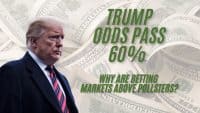Economic growth is generally measured by the gross domestic product (GDP). First-quarter GDP growth saw a revision, and it raised to 0.8% from the prior 0.5%. This report was incredibly slow, and it was also under the expectations. Bloomberg was calling for a growth of 0.9% in the revision, and Dow Jones expected growth of 1.0%.
Personal consumption was left unchanged at 1.9% in this revision, and the GDP price index was lowered to 0.6% from 0.7%.
The numbers are of course far from good, but investors and economic watchers need to understand that the first quarter was the one in which the market tanked, and international markets were spooked for the first half of the quarter, only to recover in the second half.
Goods consumption was revised up to 0.4% from 0.1%, and services consumption was lowered to 2.6% from 2.7%.
Being under 1% in the first quarter makes it harder for the United States to hit a 2.0% GDP growth for the year. Maybe there are surprises ahead from the election, but the second-quarter expectations for 2.0% growth may now depend on a recovery in oil and energy-related spending.
Stifel’s Lindsey M. Piegza, the firm’s chief economist, made a comment on this matter:
No doubt an upward revision of any size helps alleviate the pain of a weaker-than-expected first round Q1 growth report, but a minimal increase does little to reinforce optimism of better times ahead. Nevertheless, the hawks at the FOMC, already shrugging off the weakness at the start of the year, will no doubt highlight any additional upward revision as support to their thesis of fundamental strength in the U.S. economy and further evidence a rate hike less than four weeks from now is appropriate. Remember, the Fed is not looking for strong or robust or solid, just less weakness coupled with a potential side of “moderate” conditions to come over the near to medium-term.
At this point, more important than splitting hairs over weak or a slightly less weak first GDP report, the upcoming April consumption and May employment reports ahead of the June FOMC meeting will offer clear telltale signs of whether or not the weakness January to March was temporary or if earlier weakness will persist, carrying over in the second-quarter and beyond.
It is important to keep in mind that the Federal Reserve governors and presidents will be keeping their eye on more current data when they decide whether to raise interest rates in June — or to push that decision out to July. Next Friday’s unemployment and payrolls report will weight much more than first-quarter GDP revision data.
Want to Retire Early? Start Here (Sponsor)
Want retirement to come a few years earlier than you’d planned? Or are you ready to retire now, but want an extra set of eyes on your finances?
Now you can speak with up to 3 financial experts in your area for FREE. By simply clicking here you can begin to match with financial professionals who can help you build your plan to retire early. And the best part? The first conversation with them is free.
Click here to match with up to 3 financial pros who would be excited to help you make financial decisions.
Have questions about retirement or personal finance? Email us at [email protected]!
By emailing your questions to 24/7 Wall St., you agree to have them published anonymously on a673b.bigscoots-temp.com.
By submitting your story, you understand and agree that we may use your story, or versions of it, in all media and platforms, including via third parties.
Thank you for reading! Have some feedback for us?
Contact the 24/7 Wall St. editorial team.


